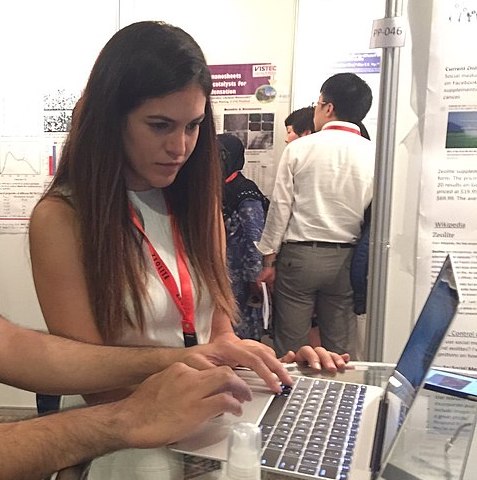Sarah Mojarad teaches a Social Media for Scientists and Engineers course at the University of Southern California where students write and improve Wikipedia articles as an assignment. Here, she shares her pedagogical motivations for doing so and the impact it has on students.

“Chemistry is often elusive but Wikipedia helps to make chemistry topics, and all topics, more accessible. It was also helpful that in the assignment we could choose the topic of information we wanted to update. Not only did it give me more agency, making the assignment more enjoyable, but it required that I update a page that I could see myself using. It is exciting knowing that I contributed to a page that others have viewed since and that I’ve perhaps helped someone learn more about a topic that interests me, and I never even had to directly connect with this person.” – Olivia Harper Wilkins, Caltech Physical Chemistry PhD Candidate
Often overlooked in higher education STEM programs, effective communication skills are highly valued and sought after in both industry and academia. Assignments that leverage STEM expertise and translate technical knowledge to the public can improve a student’s ability to communicate science. Writing for Wikipedia serves this purpose and increases the visibility of a student’s work. The platform fosters a unique, global community of writers, editors, and readers. It’s a place where students can contribute knowledge and where their work has the potential of being seen by millions of people.
Why I Use Wikipedia
The undergraduate and graduate students that enroll in my science communication course, Social Media for Scientists and Engineers, at USC (and Caltech previously) are diverse STEM majors with differing career trajectories. Throughout the term, students learn to articulate complex concepts online to audiences outside their field of study. It’s a skill that will need to be honed regardless of whether or not the student intends to pursue a career in academia or industry. The second time my course was offered at Caltech I included a Wikipedia assignment because it required students to write for non-technical, non-peer groups. The 2016 Year of Science campaign was underway at that point, so participating in the Wikipedia event was a natural fit. I believed that Wikipedia could be a good way for STEM students to write about technical topics for non-academic audiences, and the experience could demonstrate science outreach impact. Wiki Education was an ideal partner. Instructors can design assignments on their robust platform, utilize free support, and track student progress throughout the duration of the activity. The Wiki Education Dashboard also displays useful analytics, like page views on student contributions, that help quantify the impact of work.
With the Dashboard, I can create a list of approved Wikipedia pages for students to review and self-assign. To fit the diverse student audience, I chose STEM-related articles based on the academic background of course enrollees and development status of science Wikipedia pages. Offering articles that have room for improvements and that are relevant to students’ fields of study improves the overall experience them. Students then write about what they know. Thanks to the increased visibility of Wikipedia, students feel more accountable for their work than they normally would with a traditional writing assignment.
Impactful Science Writing – CRISPR
Wikipedia is a tool that can help STEM students participate in online science communication and develop confidence with their writing. The updates on the “encyclopedia anyone can edit” keep pace with scientific advancements, and science and medical pages are often high quality and accurate. Though the platform can be intimidating to new editors, each semester I see cases where students are willing to challenge themselves and write on advanced topics. For example, biomedical engineering students in my course have self-assigned CRISPR—a well-developed, highly trafficked page. Contributing to the article about CRISPR requires more coordination and interaction with other editors on the Talk page. Because it’s watched by many editors, it’s possible for student edits to be immediately reversed. These challenges have not deterred people in my course. The CRISPR contributions from three students in Social Media for Scientists and Engineers have been viewed a combined 2,946,555 times on Wikipedia.
We often associate millions of views with viral content—not classroom assignments. However, a shift in traditional teaching and learning environments is taking place thanks to the Internet. I anticipate we’ll see more classrooms adopting Wikipedia coursework into existing curriculum. After all, why write for an audience of one when writing for millions is possible?
Returning to Wikipedia Each Academic Year
I continue to use Wikipedia in Social Media for Scientists and Engineers because it is a useful form of science outreach that generates impact. Through their collaborations with other editors, revisions of existing work, and interactions in Talk pages, students become members of digital teams working towards a common goal. When I share the page view analytics with students, I see a classroom full of proud faces. Contributing to Wikipedia is a gratifying experience, and their work helps improve an open-access resource that everyone in the world uses.
Often times, the edits don’t end because the assignment is completed. Though the grading period is over, they will continue to write on Wikipedia because it’s fulfilling. In a class of STEM students, it’s tough to spark interest and excitement for writing; however, with Wikipedia this is possible.
Interested in teaching a Wikipedia writing assignment? Use our free tools and assignment templates to best adapt it to your course. Visit teach.wikiedu.org to get started.
